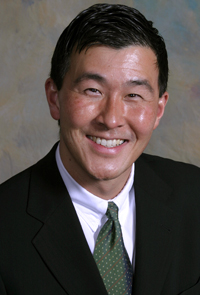UCSF's Maa Recounts Human Costs of Emergency Department Overcrowding
When John Maa’s mother died, it was an unexpected loss for which he was unprepared. As a man, it was the most difficult day of his life.
But as a son, it was the most frustrating.

John Maa, MD
Maa, MD, an assistant professor of surgery and director of the UCSF Surgical Hospitalist Program, has focused his career upon improving the delivery of emergency surgical care through the dedicated availability of a surgeon to see patients in the Emergency Room (ER) needing surgical consultation.
But when his mother was admitted to another hospital with an irregular heart beat and shortness of breath, he never expected that various delays would compromise the quality of her care. She was kept in the ER overnight because an inpatient bed was unavailable. Because of the delayed admission and limited weekend staffing, the procedures were postponed from Friday to Monday.
Ultimately, she suffered a massive embolic stroke and was intubated in the ICU without signs she’d ever neurologically recover. She was kept alive in the ICU until preparations for her funeral could be finalized. She died at noon on the following Tuesday, 112 hours after her admission to the hospital.
Maa and his family will never know if the outcome, under different circumstances, could have been different. But he does know there is a serious problem with ER overcrowding, and now he truly understands the potentially devastating consequences.
Maa recounted the sequence of events that lead to his mother’s death two-and-a-half years ago in a recent article in the New England Journal of Medicine, where he dispelled the notion that “the shortcomings that afflict our health care system affect only the poor.”
“I’m now dedicated to this problem and wish to make sense of my mother’s tragedy,” Maa said. “I wrote the piece not to be critical or excessively somber, but to enable our country to understand the realities of emergency care so we can then propose proper solutions.”
While spending much of the last year on sabbatical in Washington, DC, Maa spoke with elected officials, the newsprint, radio and television media, the US Department of Health of Human Services, and leading medical organizations to better understand the challenges in emergency care. He shared his mother’s story with leaders on Capitol Hill and the Rand Corporation, a nonprofit global policy think tank. “They all thought there was an opportunity to utilize this tragedy to improve emergency care across the country,” said Maa.
He’s deeply concerned that ERs are woefully unprepared for the implementation of the health care reform, which will grant 32 million more Americans insurance coverage and usher in other changes.
“The Affordable Care Act will add 16 million people to Medicaid, which may strain an already overwhelmed emergency care system even further,” said Maa. “Research demonstrates that Medicaid recipients are the population who use the ER most frequently, while insured people go see their regular doctors. A year from now the crisis in emergency care may be even more severe.”
Searching for New Solutions
Over the past six months, Maa visited ERs all across the country in the search of new solutions. While he says he doesn’t have the answers to this “very vexing problem,” he believes there are ways to strengthen the system based on successful changes that institutions such as UCSF Medical Center have implemented. One improvement, he says, is dedicating operating rooms for emergency cases. “Operating rooms across the country are filled with scheduled elective surgeries, while people in the ER wait on an add-on list,” he said. “In general, even if your surgery is urgent, you have to wait until elective procedures are completed first.”
At UCSF, important changes include operating rooms dedicated to emergency operations, and dedicated specialists available on the weekends and evenings. “We have to think differently about the challenges,” he said. “I think solutions may include encouraging hospitals to post ER waiting times on Twitter to help patients decide where to seek treatment, or creating a service like Opentable [the online restaurant reservation system] to schedule ER appointments.”
Coordination and regionalization are also key to giving patients across the country better access to care. “There are nearly 1,200 counties in America without a general surgeon available for emergency care. Through telemedicine, a surgeon in the Midwest could set up a computer link and help ER doctors in rural areas, evaluating the patient by camera and helping make a decision whether the patient can go home.”
While Maa will forever be personally affected by losing his mother at the hands of the health care system, as a surgeon, the experience is now informing how he cares for his patients.
“Two years later, I really empathize with my patients. I spend more time talking to them about the risks, and also have great sympathy for the doctors involved in my mother’s care. My mom was hospitalized for an irregular heartbeat, and the day she had her fatal stroke she was supposed to be discharged home. It’s intriguing that over my entire career, the most tragic outcome I have witnessed that resulted from delays in emergency care happened to my own mother.”